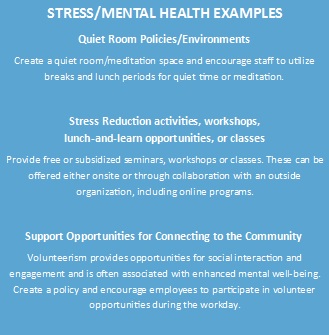Once you have assessed your worksite, it is time to choose the interventions that will make up your wellness program. But it is important to start by creating goals and objectives for your program. Remember to start simple and leave room for the program to grow. Successful worksite wellness programs combine polices that enhance health along with programs or activities that encourage employees to make healthy choices. Good communication will help promote the program, build interest, and increase participation.
Customize your program by selecting which tasks to implement.
 One Star Activities – Tasks that should be completed by every organization. These are the “must-do” basic building blocks of a wellness program.
One Star Activities – Tasks that should be completed by every organization. These are the “must-do” basic building blocks of a wellness program.

 Two Star Activities – Enhanced activities for wellness that may require dedicated staff and some financial resources.
Two Star Activities – Enhanced activities for wellness that may require dedicated staff and some financial resources.


 Three Star Activities – Suggested items that require more significant time or financial resources to implement and are value-added activities.
Three Star Activities – Suggested items that require more significant time or financial resources to implement and are value-added activities.
 Set Worksite Wellness Goals
Set Worksite Wellness Goals
Based on the results of the assessments, define what constitutes success. Consider quantitative measures such as participation and reduced absenteeism, and qualitative measures such as improved satisfaction and knowledge. It’s important for program goals to be specific and quantifiable so an effective post-evaluation can be done.
Tips
- Use the results from your policy/environmental assessment and employee needs and interests survey to inform your goals
- Goals should be S.M.A.R.T. (Specific, Measureable, Attainable, Realistic, Timely) to ensure that you can measure change over time
Helpful Links
Centers for Disease Control and Prevention – Develop SMART Objectives
 Create and Implement Your Action Plan
Create and Implement Your Action Plan
Based on the objectives you created to meet the needs and interests of your staff, select actions and programs to implement. Use the Action Plan tool on the Designing Healthy Environments at Work website to select your action items and monitor your progress online.

 Determine a Wellness Budget
Determine a Wellness Budget
Many worksite wellness programs can be implemented with no cost. However, a budget for incentives, program materials, or equipment can be helpful. Budgets help prioritize wellness activities and provide leaders with an accounting of how dollars are spent.
Although you do not have to use incentives, they can be a powerful motivator to build or maintain interest and participation in your wellness program. While financial incentives can boost participation in some events, there is little evidence that they’re effective for long-term behavior change.
Tips
- Changes to policies that support healthy choices, like flexible work hours or healthy meeting standards, can be made at no cost while having the largest impact
- Environmental changes, like installing a bicycle rack or creating a walking path, can often be accomplished through grants, donations, and volunteers. Check with local foundations and service organizations as potential resources
- Participation in programs, like walking challenges and classes, can often be increased with incentives
Helpful Links

 Communicate Your Program
Communicate Your Program
Effective communication and program branding is vital to the success of a worksite wellness program. Consistent, frequent and multi-channel communication is key to creating well informed employees and can lead to better engagement.
Tips
- Communicate using different methods to reach employees at all organizational levels
Helpful Links
Simply Put – A guide for creating easy-to-understand materials
Centers for Disease Control and Prevention – Communication Tips
***





